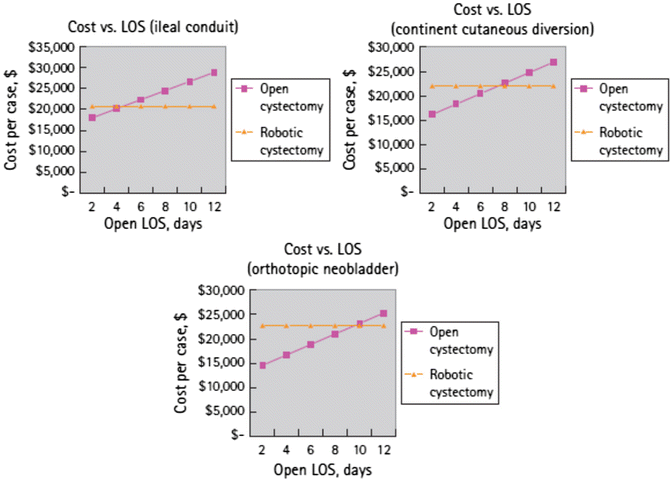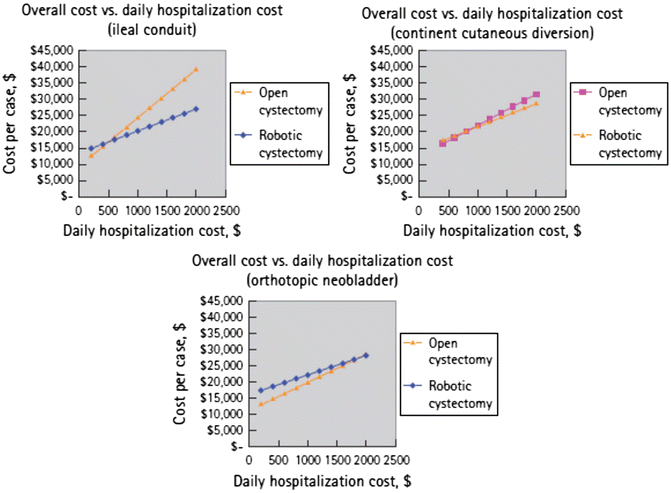Fig. 17.1
One-way sensitivity analysis of annual robotic surgical volume across ileal conduit (IC) and continent cutaneous diversion (CCD). Reprinted with the permission of the authors

Fig. 17.2
One-way sensitivity analysis of open radical cystectomy (ORC) length of stay (LOS) across all types of urinary diversions. Reprinted with the permission of the authors

Fig. 17.3
One-way sensitivity analysis of daily hospitalization costs across all types of urinary diversion. Reprinted with the permission of the authors
In sum, the studies described confirmed that RARC is more expensive than ORC in a direct cost analysis, but the additional cost impact can be abrogated by cost savings associated with lower complication rates in RARC patients as compared to those undergoing ORC. Additionally, hospital and surgical factors such as institutional robotic volume, LOS, hospitalization cost, and choice of urinary diversion can materially affect cost calculations.
There are many limitations to the cost analysis performed to date comparing RARC and ORC. Most importantly, each study draws from a single institution cohort making comparisons between studies problematic as health systems vary greatly, including measurement of costs and complications [17,18]. For example, in the study of Smith et al. [9] and Martin et al. [10], OR duration was the same or shorter for RARC vs. ORC, while in the study of Lee et al. [12], OR times were longer for patients undergoing RARC. It is difficult to fully understand all factors contributing to institutional differences in OR duration when all surgeons involved are highly experienced surgeons. Another major source of potential bias is the nonrandomized fashion in which ORC and RARC cohorts are assembled. For example, there are doubtless, immeasurable factors that contribute to a surgeon’s decision to elect one urinary diversion over another, and these decisions can be a source of potential bias.
An important institutional factor implicit in all three of these previously mentioned cost studies is the relatively large institutional yearly robotic surgical volume. Cost calculations overall, were based on robotic volumes of approximately 300 annual cases. Even with the robotic startup and maintenance costs defrayed by large case volumes, the per case direct robotic costs still dominated all analyses. Thus, most small, community hospitals are unlikely to achieve anything near cost equivalence in a RARC vs. ORC comparison. In fact, the cost-effective incorporation of a RARC program requires the presence of a robust overall robotics program. As the prevalence of bladder cancer requiring radical surgery will never equal the prevalence of prostate cancer patients undergoing radical surgery, radical prostatectomy volume must facilitate cost-effective RARC. Furthermore, the trend towards centralization of complicated medical care to tertiary care centers, may facilitate not only improve oncologic and functional outcomes but also keep per patient costs from soaring. Last, to optimally study economic considerations in bladder cancer, costing data along with utility data should be collected in a prospective fashion as a part of randomized controlled trials comparing ORC to RARC. Only through these types of studies can we truly begin to understand not just the cost of RARC, but the cost effectiveness of this evolving therapy.
Editors’ Commentary
Erik P. Castle and Raj S. Pruthi
When new technology is introduced into health care, cost considerations become a large concern and must be critically analyzed in order to determine whether the added costs are offset by the benefits provided to patients and health care as a whole. In this chapter, the authors review the few analyses that have been performed for RARC. The problem with any cost analysis is that it is very difficult to assess true “cost” as there are many definitions of this term. When we talk about cost are we referring to “cost to the hospital,” “cost to the patient,” “cost to the third party payers,” or “cost to health care”? Furthermore, cost to a hospital depends on contracts that are negotiated with industry and how their own internal accounting is performed for capital costs in the operating room. Depreciation and bottom line calculations further complicate the issue. What is certain is that new technology is rarely inexpensive and health care continues to become more expensive every day. We hope that increased utilization will drive cost down but until that happens, robotic technology will continue to be an expensive tool for surgeons. It may be that procedures such as RARC may be limited to high volume centers to compensate for the start-up and day-to-day costs. Nevertheless, we expect to see a continued rise in the integration of robotic technology in the operating room and look forward to future studies on cost.
Stay updated, free articles. Join our Telegram channel

Full access? Get Clinical Tree





